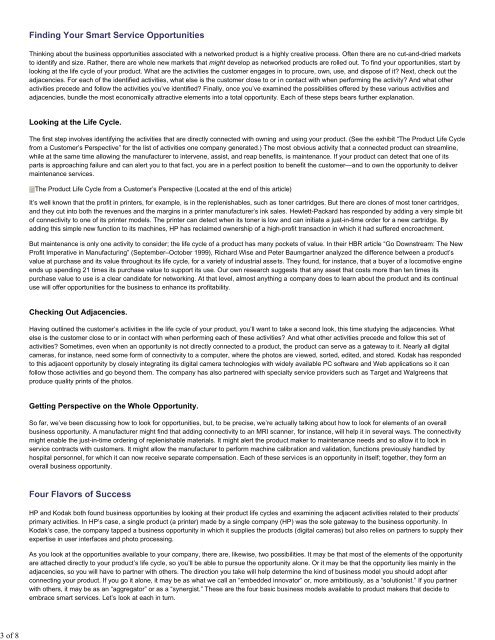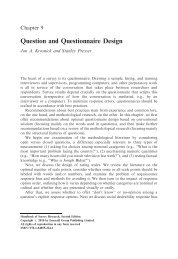Four Strategies for the Age of Smart Services - Courses
Four Strategies for the Age of Smart Services - Courses
Four Strategies for the Age of Smart Services - Courses
Create successful ePaper yourself
Turn your PDF publications into a flip-book with our unique Google optimized e-Paper software.
3 <strong>of</strong> 8<br />
Finding Your <strong>Smart</strong> Service Opportunities<br />
Thinking about <strong>the</strong> business opportunities associated with a networked product is a highly creative process. Often <strong>the</strong>re are no cut-and-dried markets<br />
to identify and size. Ra<strong>the</strong>r, <strong>the</strong>re are whole new markets that might develop as networked products are rolled out. To find your opportunities, start by<br />
looking at <strong>the</strong> life cycle <strong>of</strong> your product. What are <strong>the</strong> activities <strong>the</strong> customer engages in to procure, own, use, and dispose <strong>of</strong> it Next, check out <strong>the</strong><br />
adjacencies. For each <strong>of</strong> <strong>the</strong> identified activities, what else is <strong>the</strong> customer close to or in contact with when per<strong>for</strong>ming <strong>the</strong> activity And what o<strong>the</strong>r<br />
activities precede and follow <strong>the</strong> activities you’ve identified Finally, once you’ve examined <strong>the</strong> possibilities <strong>of</strong>fered by <strong>the</strong>se various activities and<br />
adjacencies, bundle <strong>the</strong> most economically attractive elements into a total opportunity. Each <strong>of</strong> <strong>the</strong>se steps bears fur<strong>the</strong>r explanation.<br />
Looking at <strong>the</strong> Life Cycle.<br />
The first step involves identifying <strong>the</strong> activities that are directly connected with owning and using your product. (See <strong>the</strong> exhibit “The Product Life Cycle<br />
from a Customer’s Perspective” <strong>for</strong> <strong>the</strong> list <strong>of</strong> activities one company generated.) The most obvious activity that a connected product can streamline,<br />
while at <strong>the</strong> same time allowing <strong>the</strong> manufacturer to intervene, assist, and reap benefits, is maintenance. If your product can detect that one <strong>of</strong> its<br />
parts is approaching failure and can alert you to that fact, you are in a perfect position to benefit <strong>the</strong> customer—and to own <strong>the</strong> opportunity to deliver<br />
maintenance services.<br />
The Product Life Cycle from a Customer’s Perspective (Located at <strong>the</strong> end <strong>of</strong> this article)<br />
It’s well known that <strong>the</strong> pr<strong>of</strong>it in printers, <strong>for</strong> example, is in <strong>the</strong> replenishables, such as toner cartridges. But <strong>the</strong>re are clones <strong>of</strong> most toner cartridges,<br />
and <strong>the</strong>y cut into both <strong>the</strong> revenues and <strong>the</strong> margins in a printer manufacturer’s ink sales. Hewlett-Packard has responded by adding a very simple bit<br />
<strong>of</strong> connectivity to one <strong>of</strong> its printer models. The printer can detect when its toner is low and can initiate a just-in-time order <strong>for</strong> a new cartridge. By<br />
adding this simple new function to its machines, HP has reclaimed ownership <strong>of</strong> a high-pr<strong>of</strong>it transaction in which it had suffered encroachment.<br />
But maintenance is only one activity to consider; <strong>the</strong> life cycle <strong>of</strong> a product has many pockets <strong>of</strong> value. In <strong>the</strong>ir HBR article “Go Downstream: The New<br />
Pr<strong>of</strong>it Imperative in Manufacturing” (September–October 1999), Richard Wise and Peter Baumgartner analyzed <strong>the</strong> difference between a product’s<br />
value at purchase and its value throughout its life cycle, <strong>for</strong> a variety <strong>of</strong> industrial assets. They found, <strong>for</strong> instance, that a buyer <strong>of</strong> a locomotive engine<br />
ends up spending 21 times its purchase value to support its use. Our own research suggests that any asset that costs more than ten times its<br />
purchase value to use is a clear candidate <strong>for</strong> networking. At that level, almost anything a company does to learn about <strong>the</strong> product and its continual<br />
use will <strong>of</strong>fer opportunities <strong>for</strong> <strong>the</strong> business to enhance its pr<strong>of</strong>itability.<br />
Checking Out Adjacencies.<br />
Having outlined <strong>the</strong> customer’s activities in <strong>the</strong> life cycle <strong>of</strong> your product, you’ll want to take a second look, this time studying <strong>the</strong> adjacencies. What<br />
else is <strong>the</strong> customer close to or in contact with when per<strong>for</strong>ming each <strong>of</strong> <strong>the</strong>se activities And what o<strong>the</strong>r activities precede and follow this set <strong>of</strong><br />
activities Sometimes, even when an opportunity is not directly connected to a product, <strong>the</strong> product can serve as a gateway to it. Nearly all digital<br />
cameras, <strong>for</strong> instance, need some <strong>for</strong>m <strong>of</strong> connectivity to a computer, where <strong>the</strong> photos are viewed, sorted, edited, and stored. Kodak has responded<br />
to this adjacent opportunity by closely integrating its digital camera technologies with widely available PC s<strong>of</strong>tware and Web applications so it can<br />
follow those activities and go beyond <strong>the</strong>m. The company has also partnered with specialty service providers such as Target and Walgreens that<br />
produce quality prints <strong>of</strong> <strong>the</strong> photos.<br />
Getting Perspective on <strong>the</strong> Whole Opportunity.<br />
So far, we’ve been discussing how to look <strong>for</strong> opportunities, but, to be precise, we’re actually talking about how to look <strong>for</strong> elements <strong>of</strong> an overall<br />
business opportunity. A manufacturer might find that adding connectivity to an MRI scanner, <strong>for</strong> instance, will help it in several ways. The connectivity<br />
might enable <strong>the</strong> just-in-time ordering <strong>of</strong> replenishable materials. It might alert <strong>the</strong> product maker to maintenance needs and so allow it to lock in<br />
service contracts with customers. It might allow <strong>the</strong> manufacturer to per<strong>for</strong>m machine calibration and validation, functions previously handled by<br />
hospital personnel, <strong>for</strong> which it can now receive separate compensation. Each <strong>of</strong> <strong>the</strong>se services is an opportunity in itself; toge<strong>the</strong>r, <strong>the</strong>y <strong>for</strong>m an<br />
overall business opportunity.<br />
<strong>Four</strong> Flavors <strong>of</strong> Success<br />
HP and Kodak both found business opportunities by looking at <strong>the</strong>ir product life cycles and examining <strong>the</strong> adjacent activities related to <strong>the</strong>ir products’<br />
primary activities. In HP’s case, a single product (a printer) made by a single company (HP) was <strong>the</strong> sole gateway to <strong>the</strong> business opportunity. In<br />
Kodak’s case, <strong>the</strong> company tapped a business opportunity in which it supplies <strong>the</strong> products (digital cameras) but also relies on partners to supply <strong>the</strong>ir<br />
expertise in user interfaces and photo processing.<br />
As you look at <strong>the</strong> opportunities available to your company, <strong>the</strong>re are, likewise, two possibilities. It may be that most <strong>of</strong> <strong>the</strong> elements <strong>of</strong> <strong>the</strong> opportunity<br />
are attached directly to your product’s life cycle, so you’ll be able to pursue <strong>the</strong> opportunity alone. Or it may be that <strong>the</strong> opportunity lies mainly in <strong>the</strong><br />
adjacencies, so you will have to partner with o<strong>the</strong>rs. The direction you take will help determine <strong>the</strong> kind <strong>of</strong> business model you should adopt after<br />
connecting your product. If you go it alone, it may be as what we call an “embedded innovator” or, more ambitiously, as a “solutionist.” If you partner<br />
with o<strong>the</strong>rs, it may be as an “aggregator” or as a “synergist.” These are <strong>the</strong> four basic business models available to product makers that decide to<br />
embrace smart services. Let’s look at each in turn.
















